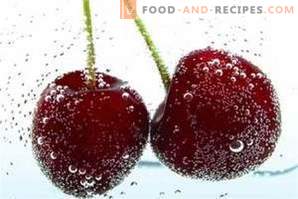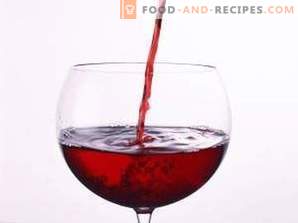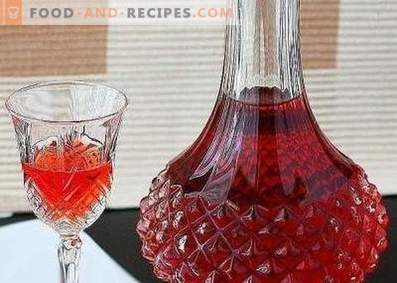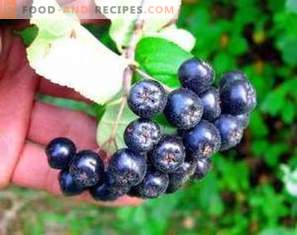
Despite the fact that now the range of alcoholic beverages is large, homemade wine is in great demand. Especially if it is made from the best varieties of fruits and berries.
Along with the grape wine, winemakers prepare cherry. This thick dark red wine has an extraordinary aroma and refined taste. But to make it happen that way, you need to follow all the rules of winemaking.
Cherry can be used to prepare both dry and semi-sweet wines, as well as dessert wines.
Subtleties
- The quality of the wine directly depends on which berries were used to make it. For cherry wine is best to take dark-colored cherries more acidic varieties. A good wine is obtained from cherries with black fruits. Cherry varieties Vladimirskaya, Consumer goods, Shubinka wine will have a densely colored color. From the Polevka or Lyubskaya wine variety it turns out not with such a saturated color, but with a more original smell and aroma.
- Cherry wines do not require long exposure. They are well lightened. They can be used already in the year of manufacture.
- Cherry must be ripe, without wormholes. You can take over-ripe berries, the main thing - that they were not moldy and rotten.
- They should never be washed, so as not to wash away the wild yeasts that are on the surface of the berries. For the same reason, you should not use berries collected after a heavy rain, as it washes away the yeast. Sourdough of these berries ferment badly, and the wine can moldy.
- It is better to clean the cherry in dry weather and start preparing the wine on this particular day.
- The bones from the cherries are not removed, because during fermentation, they themselves are separated from the pulp and are easy to remove in the process of straining. And also in wine from cherries with stones there are pluses. This wine is more tart and fragrant.
- The strength of a wine depends on the amount of sugar, because it is alcohol that is produced during fermentation.
- Wine is best fermented in pure yeast cultures. If the pulp ferments well, then you can not add the leaven. But still better to cook it in advance. It is made 10 days before picking cherries and starting to make wine.
- To make a leaven, knead two glasses of unwashed berries (grapes, strawberries, raspberries), place in a bottle. Add 100 g of sugar and 250 ml of boiled water. Everything is well shaken, sealed with a cotton stopper and put in a dark warm place for a few days. After 4 days, the berry mass will ferment. It is filtered and added to the future of wine. To get a dessert wine, take 10 g of wort with 300 g of yeast. If they want to get a semi-sweet or dry wine, put the starter culture 100 ml less.
- Cherry - sour berry. To reduce its natural acidity, the juice is diluted with water. Add so much water that it is pleasant to drink the juice. The amount of water also depends on the type of cherry. For example, a 10 liter juice from a Lyubskaya cherry variety requires 3, 7 kg of sugar and 3, 8 l of water. And they don’t add water at all to the juice from Samsonovka cherry, but they put 2, 2 kg of sugar in it. As a result, the strength of the wine turns 14-16 °.
- After fermentation, the wine is clarified to remove leftover pulp, as well as yeast and bacteria. The wine is drained, leaving the sediment, approximately 3 days after the end of fermentation. Wine defend 1-1, 5 months, and then re-removed from the sediment. During this period, you can add a little more sugar to the wine: 150 g per liter.
- Separation of wine from sediment is a prerequisite for obtaining high-quality products. Therefore, the wine must be periodically poured from one container to another, using a thin rubber hose.
- In order to make wine, especially lightly bonded, not soured, it is pasteurized. To do this, bottles of wine are closed with corks, tied with twine, put in a high saucepan with water. Heat to 60 ° for 15 minutes. Then the wine is slowly cooled.
- There is a hot bottling of wine. The wine is poured into the pan, heated to 60 °. After 2 minutes, bottled. Corked.
Cherry wine: the first recipe
Ingredients:
- cherry - 3 kg;
- water - 4 l;
- sugar - 1, 5 kg.
Preparation Method
- Sort out unwashed cherries, remove spoiled berries. Pour into a barrel or container with a wide neck.
- Mash the berries with your hands as carefully as possible. Add a pound of sugar and pour warm water. Stir to dissolve sugar.
- Cover the container with a clean cloth and place in a warm place. After a few hours, fermentation will begin and a “cap” of foam will appear. It needs to be mixed several times a day.
- After about 4 days, separate the pulp from the wort and place it under the press to drain the remaining juice. Strained wort poured into the bottle. Add another pound of sugar and mix thoroughly, vigorously shaking the bottle. There should be enough space in the pot for the foam that will appear during fermentation. Close the container with the future wine stopper with a branch tube, the end of which is immersed in a jar of water. Put the bottle in a warm place for another 4-5 days for further fermentation.
- Then pour the wort into a clean bottle, add another 250 g of sugar and mix thoroughly. Put the remaining sugar in 4 days.
- When the wine almost stops fermenting (this will be seen by the absence of carbon dioxide bubbles in the can of water), transfer it carefully to another container using a rubber tube.
- Let the wine settle for a while and pour it into the bottle. Well close the neck traffic jams. Put in a dark cool place to brighten. When a sediment appears at the bottom of the bottles, pour the wine into a clean container and leave it for further settling. The first time is poured in 15-20 days, then it can be done less often.
- When the wine is clear, carefully pour it into clean, dry bottles and stoppered with corks. Keep in a cool place.
Cherry wine: the second recipe
Ingredients:
- cherry - 10 kg;
- sugar - 5 kg;
- raspberry - 1 plate;
- water - 6 l.
Preparation Method
- Sort out unwashed cherries, remove spoiled berries. Fold into a large saucepan or keg. Add unwashed raspberries.
- Add 1 kg of sugar. Stir, cover with gauze and leave in a warm place for a day.
- Next day, pour water into the cherry mass and mix again. Repeat this procedure for two more days, each time dosypaya to a kilogram of sugar.
- Throughout all these days, stir the cherry mixture with your hands, while crushing the cherries so that the bones are separated from the pulp. You will see how the mass will wander well, being covered from above with an abundant cap of foam.
- In 5-6 days the pulp of the berries will separate from the bones and rise to the surface, and the bones will be on the bottom.
- Strain the pulp through a sieve into another container. Well press a thick mass on a press or with the help of a fabric pouch. The remaining juice connect with the rest of the wort. If the cherries were very sour, you can add another 2-3 liters of water. Bone and thick mass throw away.
- Drain all the wort into a twenty-liter bottle, filling with wort only 2/3 volume, and put the shutter. You can close the bottle with a stopper with a branch tube, the end of which is immersed in a jar of water. This should be done in order to carbon dioxide, which will be released in the fermentation process, out through the tube, and did not get inside the oxygen, which can turn the wine into vinegar.
- Put the bottle in a warm place, as in the cool fermentation almost does not occur. At a temperature of about 25 °, vigorous fermentation lasts for 15 days (sometimes up to 30 days). Gradually, it will subside.
- When carbon dioxide almost ceases to be released (you will notice it by single air bubbles in a jar of water), the remaining pulp will settle to the bottom of the container.
- After about 1-1.5 months, the wine will need to be drained and poured into another bottle. To do this, use a rubber hose. Pour out the sediment that remains on the bottom.
- After a month, pour the wine a second time. Try the taste. Sweeten if necessary. To prevent the wine from becoming acidic, it is recommended to add a little alcohol or good vodka.
- Wine bottled, corked and tar.
Cherry Wine: A Simple Recipe
Ingredients:
- cherry - 10 kg;
- sugar - 5 kg.
Preparation Method
- Sort out unwashed cherries, removing all bad berries. Without removing the seed, fold it into a suitable container, pouring sugar into layers. Cover and place in a cool place.
- Due to the large amount of sugar, the digestion process will take place gradually and the berries will not sour.
- Stir the mass periodically to dissolve the sugar faster. Then squeeze the berries.
- Strain the wort through several layers of gauze.
- Prepackaged in bottles. This wine is stored in the cellar or in the refrigerator.
Frozen Cherry Wine
Ingredients:
- cherry - 5 kg;
- sugar - 1, 5 kg;
- water - 3 l;
- raisins - 100 g.
Preparation Method
- Place frozen cherries in a saucepan and thaw at room temperature.
- Carefully knead the berries with your hands. Add sugar and pour water. Add unwashed raisins. Stir.
- Cover the pan with a lid and place in a warm place for fermentation.
- Thanks to active fermentation, the berries will be covered with a foam cap. Stir the berry mass periodically to completely dissolve the sugar.
- After about 7-10 days, when the active fermentation stops, squeeze the pulp and strain the juice and pour it into the bottle, filling 2/3 volume to leave space for the foam caused by the fermentation. Cover the container with a lid or stopper with a branch tube, the end of which is immersed in a jar of water. This should be done to ensure that carbon dioxide emitted by the wort does not turn the wine into vinegar.
- When fermentation stops, carefully pour the wine into another bottle, and pour out the sediment. After some time, re-pour the wine.
- Bottled, capped and stored in a cool place.
Mistress to note
So that wine does not turn into vinegar during maturation, it should not be in contact with air. To do this, and make cork or cover with water seal. If you don’t have them, use a regular rubber glove that you can buy at a hardware store or a pharmacy. Put it on the neck of the bottle or can, fasten. The carbon dioxide that will be released from the wort during fermentation will fill the glove and it will inflate. This will indicate that the fermentation process is still in full swing. To prevent the glove from bursting from excessive pressure, make a hole in it with a needle. Carbon dioxide will easily go outside, and air cannot get inside.
As soon as the glove sags, fermentation has stopped and the wine is ready. It remains only to pour it into another container, filter, clarify and let stand.
Wine is stored in a horizontal position so that the cork is immersed in it. This method will not allow air to enter the bottle and affect the quality of the wine.
The optimum temperature in the room should be around 8 °.
A well-aged wine should be a beautiful red color and completely transparent.
When bottling sediment left at the bottom of the bottle along with the remnants of wine.























